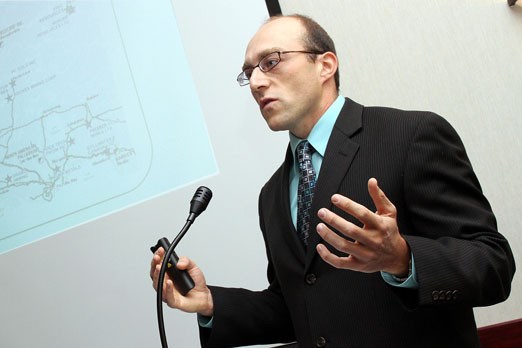An independent report on the impact of mining in the province suggests nine projects already underway could result in up to 13,149 jobs in Northwestern Ontario
And that’s just the tip of the iceberg.
With combined mineral assets of $135 billion in the ground, the value to government coffers could be staggering, though they will have to spend money to make it. The study says it will cost about $1.7 billion in transportation, energy and communications infrastructure to score the estimated $16 billion in taxes the mines will generate, say the authors of Mining in Northwestern Ontario: Opportunities and Challenges, commissioned by Ambassadors Northwest.
All told the mines, including a pair in the Ring of Fire, could create up to 23,588 new jobs, 8,107 during construction phases and another 15,481 when mining operations are under way.
City manager Tim Commisso said the key for Thunder Bay to capitalize on the wealth is to start preparing now. Municipalities as a whole can expect to rake in 22 per cent of the taxation pie, with 43 per cent going to Ottawa and the remaining 35 per cent to Queen’s Park.
Commisso admitted the city is not ready at the present time, but with plenty of lead time, he’s convinced it can get there, calling it a baseline study to work outward from.
“This is a good problem to have where you know we’re not ready right now, but here’s what we need to do next,” Commisso said.
“My biggest concern quite frankly is getting the industrial land and the residential land available. The private sector is obviously going to respond, but they can’t do that without having land.”
There is no danger in things happening too fast for city officials to keep up, Commisso added.
“The reality is there’s already a lot of traction. Things are happening. It’s just a question of taking advantage and optimizing the opportunity. The opportunity will happen. To me the key is getting infrastructure in place and getting a really strong framework for working with First Nations,” said Commisso, noting the city will spend the next few months identifying what will be needed through its mining readiness strategy and will then put it in place.
“I think we’re ahead of the curve.”
Bahram Dadgostar, the dean of the faculty of business at Lakehead University and lead author of the study, said the numbers they produced were in fact conservative estimates.
The value of the mines and the number of jobs could in fact be much higher. This could lead to another problem.
“If exploration of these nine mines comes to production, we know the number of employment for this region are going to be more than what we estimated. The difficulty and the challenges of what we’re facing is where those laborers and experts are going to come from,” said Dadgostar, who also recommended a change of thinking at the high school level and better marketing of mining as a desirable career.
Confederation College president Jim Madder said the programs are in place, but the school must get the students into the classroom.
“I think we should have people from Northwestern Ontario training for the first opportunity at those jobs,” Madder said. “Even if we do that we’re probably still going to import people.”
The government has to be willing to spend a little money to make a little money to make it work, Dadgostar said, but it’s not the biggest obstacle standing in the way of their study becoming a reality.
“Industries are not these days ready or eager to put money into infrastructure. This is the time the government should step in and say, ‘We’ll get $16 billion,’ and around $1.7 billion is nothing compared to $16 billion.”
Thunder Bay Chamber of Commerce president Harold Wilson said what strikes him about the study is the projects being studied are close to being ready or already under development.
He said the study could be a key tool in convincing all levels of government that this is a great opportunity not only for the North, but the entire province.
“Let’s take a look at what that return on investment is of the infrastructure, but also the regulatory side. Let’s expedite this,” he said.
All agreed First Nations must be at the table throughout the process. In fact, the study listed it as the No. 1 issue facing the developments.
Coun. Iain Angus acknowledged relationships with Aboriginal communities haven’t been the smoothest during the mining boom’s infancy.
Senior levels of government must recognize they have a right to engagement and consultation, and it must come from Ottawa and Toronto.
“Both the Canadian government and Ontario government have to accept their responsibilities and start being proactive in providing the leadership and working with the First Nations and working with the interested companies that want to access traditional lands,” Angus said.
Nishnawbe Aski Nation Grand Chief Harvey Yesno was not immediately available for comment on Thursday.
